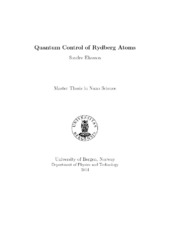| dc.contributor.author | Eliasson, Sondre Hilmar Hopen | eng |
| dc.date.accessioned | 2014-09-24T11:11:05Z | |
| dc.date.available | 2014-09-24T11:11:05Z | |
| dc.date.issued | 2014-06-02 | eng |
| dc.date.submitted | 2014-06-02 | eng |
| dc.identifier.uri | https://hdl.handle.net/1956/8541 | |
| dc.description.abstract | In 2007 the AEGIS experiment was started at CERN with the goal to determine the gravitational acceleration of the antihydrogen atom. This is achieved through accelerating the antihydrogen atoms toward a detector and measure the path of flight. To achieve the desired accuracy of the measurement, a large enough amount of antihydrogen atoms have to reach the detector. To obtain this objective, the use of quantum polarization control has been put forward. The main obstacle turns out to be the large unknown number of initial states, the limited numbers of coupling and the symmetry of the dynamics. In the thesis, quantum control in the time domain is described and applied to Rydberg atoms. A code has been modified and extended with respect to unknown initial conditions. Several applications of the code illustrate the given challenge. In addition, controlled excitation (or de-excitation) indicate that increased initial polarization can be achieved. | en_US |
| dc.format.extent | 2733382 bytes | eng |
| dc.format.mimetype | application/pdf | eng |
| dc.language.iso | eng | eng |
| dc.publisher | The University of Bergen | en_US |
| dc.title | Quantum Control of Rydberg Atoms | en_US |
| dc.type | Master thesis | |
| dc.rights.holder | Copyright the author. All rights reserved | en_US |
| dc.description.localcode | MAMN-NANO | |
| dc.description.localcode | NANO399 | |
| dc.subject.nus | 752902 | eng |
| fs.subjectcode | NANO399 | |
